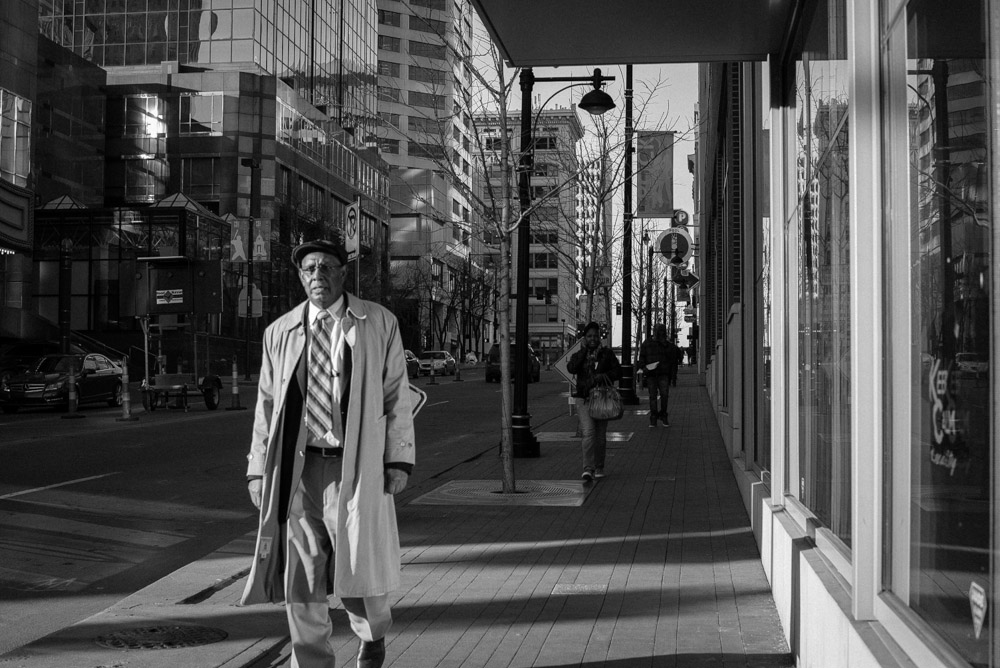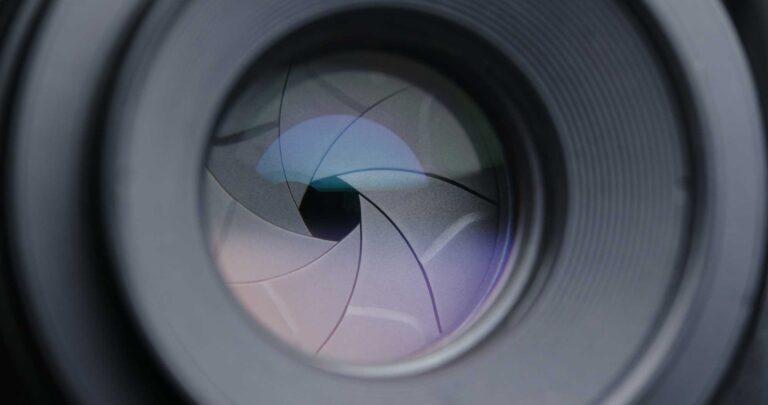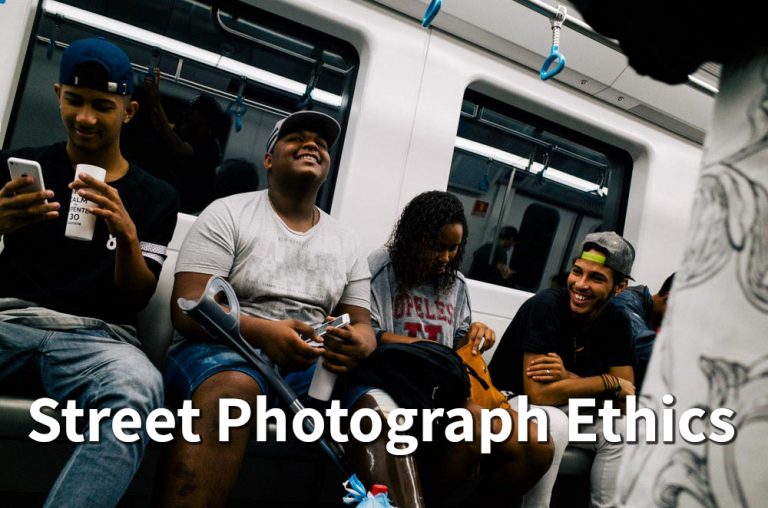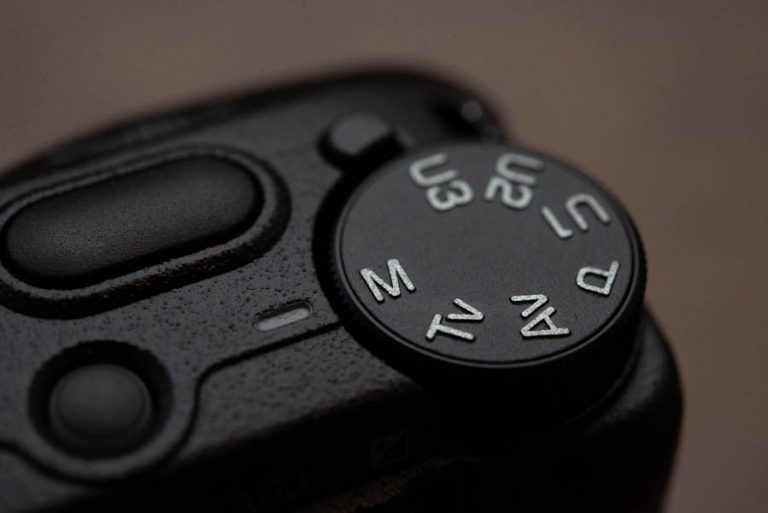35mm vs 50mm Street Photography: Choosing the Right Focal Length
Trying to decide between 35mm and 50mm lenses for street photography isn’t an easy decision for many photographers.
After all, there are many examples of excellent street photographers who have shot with 35mm lenses and the same goes for 50mm lenses.
Ultimately, one isn’t ‘better’ than the other; it comes down to your personal preference as a photographer.
However, my personal experience of owning lenses of each of these focal lengths for an extended period of time may help in your decision between the two.
50mm Lenses for Street Photography

50mm lenses have earned their place in street photography history due to street photography legends such as Henri Cartier-Bresson and Elliot Erwitt choosing it as their preferred focal length.
Considering such renowned photographers of the genre endorsed the focal length, it makes sense for any aspiring street photographer to give it some consideration.
Reasons to Shoot With a 50mm Lens for Street Photography
There are plenty of reasons to shoot with a 50mm lens over a 35mm for doing street photography. This list is not exhaustive, and you might find some unique reasons of your own for preferring the 50mm focal length over 35mm, but here are some of the big ones:
Comfortable Shooting Distance
If you have any discomfort from photographing people up close (which a lot of people do, especially if you’re just starting out), then a 50mm can be the better option for you. Compared to a 35mm where you have to get within about a meter to two meters to fill the frame with a subject, with a 50mm you can do that from a few steps back.
I shot this photo from about halfway across the street:

Had I shot this from the same distance with a 35mm lens, the shot would have been unusable unless I cropped it due to how small the main subject would have been in the frame. That’s not to say I couldn’t crop it, but it’s just something I try to avoid doing as much as possible.
The main point is that I was able to include the man in the front of the frame from a comfortable distance without getting into his personal space. I don’t think he even noticed I took the shot.
Had I been shooting with a 35mm lens, I would have had to have shot it from several steps closer to get similar framing. If the thought of that makes you uncomfortable, shooting with a 50mm lens may be your best bet due to the longer distances you’ll be shooting from.
50mm Lenses Have Very Little Distortion and Great Image Quality
Another that 50mm lenses have
You may appreciate the 50mm focal length if you prefer your human subjects not be distorted. You might appreciate it for doing architectural/urban landscape-style street photography as well.
Many photographers who do the more architectural type street photography place a big importance on having straight lines. And indeed, if these lines are at the edges of your frame and appear distorted, it can distract from the composition. With 35mm lenses and wider, these lines can appear to bend outward whereas if you were looking at the same scene with your own eyes or with a 50mm lens, the lines would be straight.
On top of that, lens manufacturers have been making 50mm lenses for decades now. This means they’ve gotten to the point where they know the processes for producing and optimizing them inside and out (although the same can be said for 35mm lenses).
Compact Size
The simpler physics of gathering light through 50mm lenses and the fact they require fewer glass elements and other moving parts than zoom lenses means that 50mm lenses can be made at more compact sizes.
To me, having my street photography equipment be small and discreet is very important. There are multiple reasons for this.
For one, the smaller my camera, the more likely I am to take it with me wherever I go. And even when I plan on going out specifically to do street photography, having a compact camera and lens feels like less of a burden and makes me more excited to shoot.
Lastly, the bigger the camera, the more attention you draw to yourself. I’m not trying to sneak around or anything while out on the streets, but I do prefer not altering the scenes that I photograph. Much fewer people notice what I’m doing when I’m using a compact camera/lens for street photography.
Very Affordable Prices
Similar to the point I made in the section above, 50mm lenses are less demanding when it comes to design compared to some other lenses. Many photographers use them as well, so the high demand means they can produce them at
Carrying a cheap nifty fifty around the street with you may also put your mind at ease. If you bring an expensive lens with you to do street photography and you’re constantly worried about losing it, breaking it, or having it stolen then you’re not going to be reaching your creative potential.
Where 50mm Lenses Fall Short for Street Photography
As with any focal length, there are some downsides to 50mm lenses.
They Can Be Too Tight
The biggest issue you’ll probably run into when doing street photography is not having enough room in tight spaces to capture the scene the way you want. Indoor spaces where you’re dealing with less room
Whereas when you’re on an open street it’s no problem, being indoors (or tight spaces like marketplaces) may mean not being able to back up far enough due to a wall, subway tracks, or one of the other many things that could possibly get in your way.
With a 35mm lens, it’s much less likely that you’ll encounter these situations where you can’t back up far enough from your subjects. I’d go so far as to say that it rarely ever happens with the 35mm focal length.
The reasons being are for one, 35mm lenses are obviously wider, and even for shots that you don’t nail with a 35mm lens in a tight space, you have the option of
The only occasions when I felt like I absolutely needed something wider than 35mm while doing street photography, like a 28mm, for specific shots were in really tight spaces, such as subway cars or public buses.
50mm Lenses Produce a Far-Away Perspective
Due to the more compressed perspective they provide, 50mm lenses produce a look and feel that makes it obvious it was shot from a distance. 35mm lenses, on the other hand, produce a look and perspective very similar to what the human eye sees while walking down the street.
It sparks the imagination of the viewer and makes them feel as if they were right there on the street where it was shot. It’s raw and real.
Photos shot with 50mm lenses have a different feel to them. They have a perspective from slightly afar, resulting in a look that makes it seem like it was seen from a faraway observer, rather than an active participant in the scene.
Street photography is entirely subjective though and you may find that you prefer this look.
Less in Focus
At equivalent focal lengths, a 50mm lens will have shallower depth of field than a 35mm.
This is a big deal for me and my street photography because I strive to get as much in focus as possible. Shooting with everything in focus is a bigger challenge than shooting with a bunch of bokeh/blown out backgrounds because you have to rely on your composition. By having your background blurred out, you can eliminate a lot of distracting elements, but I’m not a fan of removing all context in street photographs.
I think it makes for much more interesting photos if you remove the distracting elements by subtracting them from your framing or finding a way to incorporate them in your compositions in a pleasing way.
In short, it’s easier to get more in focus with 35mm lenses than it is with 50mm lenses.
35mm Lenses for Street Photography

35mm lenses are another classic street photography focal length and definitely worth considering.
Some notable street photographers who have shot/shoot with 35mm lenses include:
Although there are some overlapping pros and cons with 35mm and 50mm lenses, you’ll find there are some significant distinctions between the two.
Reasons for Using 35mm Lenses on the Streets
There are multiple reasons for using a 35mm lens for street photography. I could be your only focal length your whole life if you get used to it.
It Has an Intimate Perspective
35mm lenses are on the wide side, but not ridiculously so. In other words, it’s wide, but not too wide. It’s a nice sweet spot.
This wide perspective is just a bit wider than what the human eye sees, which means photos shot with a 35mm lens look very up close and personal (when the photographer was standing close, of course).
As a viewer, it makes you feel like you’re standing among the people who were photographed because the photographer literally was.
Comparatively, photos shot with a 50mm lens have a less intimate look to them, although it’s not like you’re looking through a telescope or anything.
You Get More in Focus
Even at relatively wide apertures, 35mm lenses have a decent amount of the frame in focus.
With longer focal lengths, you get a flattening of the focal plane. You get less of that with 35mm lenses so the end result is a greater distance that’s in focus.
One of the important benefits of this is being able to include layers in your photos. Layered street photography images with multiple subjects are the most compelling images to me because that’s how life really is on the street. Everyone on the street has their course affected by other people they encounter and no one person exists in isolation.
The street photographs that most speak to me show this in an interesting way.

Compact Size/Light Weight
Your average 35mm or equivalent focal length lens may be slightly larger than the average 50mm lens, but they’re usually a relatively manageable size, at least compared to the sizes you get with zoom lenses. They’re also reasonable in regards to their weight.
However, this does NOT apply to the really wide aperture f/1.4 and wider 35mm lenses, as those lenses are very large and heavy. It’s not my idea of a good time lugging around lenses that big and heavy.
Fast Aperture Options
This is a positive feature of most prime lenses in general, including 50mm lenses and not just specific to 35mm lenses, but primes can have somewhat fast apertures and still keep size and weight to a minimum, unlike with zooms.
I wouldn’t go for the 35mm lenses with f/1.4 maximum apertures and wider because they’re too big for street photography in my opinion, but f/2 lenses are usually sufficient to get enough light and there are some decent f/1.8 35mm options as well.
What You May Not Like About 35mm Lenses for Street Photography
Before you go out and buy a 35mm lens for doing street photography, know that there are some things that you might end up not liking about the focal length.
It May be too Wide for Your Taste
If you’ve seen street photographs shot with a 35mm lens and liked the aesthetic better than other focal lengths, that’s what’s most important. But who knows? If you try it and find that getting up close to people on the street makes you extremely uncomfortable then maybe it’s not the right focal length for you.
On the other hand, I believe that with enough familiarity with the focal length that almost anyone can overcome the fear of photographing up close on the street.
In regards to the wide perspective you get with 35mm lenses, whether you like that or not is up to you. If you prefer the slightly more flattened and further away perspective you get with 50mm lenses or longer, then
Distortion
With 35mm lenses, you’re not going to get extreme distortion like what you see with photos shot with
However, many 35mm lenses have some amount of distortion, at least at the edges of the frame. I find the slight curvature of the focal plane in photos shot with 35mm lenses to be more aesthetically pleasing, possibly due to it being similar to what the eyes see, so make of it what you will.
Which Should You Choose? 50mm or 35mm?
50mm and 35mm lenses each have their own unique characteristics, and this is an entirely subjective topic, so I can only share my opinion rather than give any kind of definitive answer.
But my pick for street photography is 35mm.
I prefer the perspective that it provides. In other words, I like the photographs that 35mm lenses produce, not any 35mm lens itself.
If there’s any real recommendation I can give on this topic though, is not to go out and buy a 35mm lens because it’s what I shoot with, but to go out and try a 50mm lens and a 35mm lens if you’re seriously trying to make a choice between the two. It’s you
You may be completely surprised by what you find compared to what you may have heard or read about these focal lengths.
I cover similar topics and my overall approach to street photography in my article on street photography tips.






